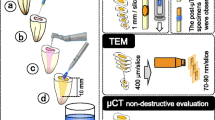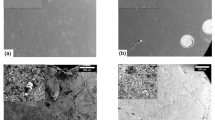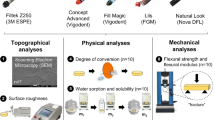Abstract
The study aimed to synthesize, characterize, and assess dentin bonding, ion-release, and degree of conversion (DC) of experimental adhesive (EA) with and without 5 wt% and 10 wt% calcium fluoride (CaF2) nanocrystals. The CaF2 nanocrystals were synthesized and characterized with scanning electron microscopy (SEM), line-Energy Dispersive X-Ray (EDX) spectroscopy, Fourier-transform infrared (FTIR).and micro-Raman spectroscopy techniques. Adhesives were characterized using micro-tensile bond strength test (μTBS), SEM–EDX spectroscopy, inter-facial failure investigation, adhesive-dentin interface examination, ion release measurements, FTIR, and DC analysis. One hundred five (n = 105) teeth were collected, their dentinal tissue was exposed, and the adhesives were applied pre-characterization of the adhesives. On SEM, CaF2 nanocrystals were seen as irregularly shaped agglomerates. The EDX mapping demonstrated calcium and fluoride’s presence for the CAF-5% and CAF-10% groups. The FTIR and micro-Raman spectra indicated characteristic bands for CaF2 containing materials. For the NTC samples, the highest μTBS (33.87 ± 3.26 MPa) was observed for CAF-10%. For the TC samples, the highest μTBS (30.48 ± 3.41 MPa) was observed for CAF-10%. Adhesive type failures were most common and the CaF2 containing adhesives revealed comparable resin tag formation to the controls. The presence of calcium and fluorine on EDX analysis was observed for CaF2 adhesives. For the CaF2 adhesives, an increased release of both ions was seen with a lowering pH and a lower DC was observed. Reinforcing of EA with CaF2 filler improves its mechanical properties. Further studies exploring the effect of diverse filler concentrations on different properties of the adhesive are warranted.






Similar content being viewed by others
Availability of data and material (data transparency)
Not applicable.
Code availability (software application or custom code)
Not applicable.
References
Abou Neel EA, Aljabo A, Strange A, Ibrahim S, Coathup M, Young AM et al (2016) Demineralization-remineralization dynamics in teeth and bone. Int J Nanomedicine 11:4743–4763
Aguiar TR, de Oliveira M, Arrais CA, Ambrosano GM, Rueggeberg F, Giannini M (2015) The effect of photopolymerization on the degree of conversion, polymerization kinetic, biaxial flexure strength, and modulus of self-adhesive resin cements. J Prosthet Dent 113:128–134
AlFawaz YF, Almutairi B, Kattan HF, Zafar MS, Farooq I, Naseem M et al (2020) Dentin bond integrity of hydroxyapatite containing resin adhesive enhanced with graphene oxide nano-particles-An SEM, EDX, micro-raman, and microtensile bond strength study. Polymers (basel) 12:2978
Al-Hamdan RS, Almutairi B, Kattan HF, Alsuwailem NA, Farooq I, Vohra F et al (2020) Influence of hydroxyapatite nanospheres in dentin adhesive on the dentin bond integrity and degree of conversion: a scanning electron microscopy (SEM), Raman, Fourier Transform-Infrared (FTIR), and microtensile study. Polymers (basel) 12:2948
Alhenaki AM, Attar EA, Alshahrani A, Farooq I, Vohra F, Abduljabbar T (2021) Dentin bond integrity of filled and unfilled resin adhesive enhanced with silica nanoparticles-an SEM, EDX, Micro-Raman, FTIR and micro-tensile bond strength study. Polymers (basel) 13:1093
Alqarawi FK, Alkahtany MF, Almadi KH, Ben Gassem AA, Alshahrani FA, AlRefeai MH et al (2021) Influence of different conditioning treatments on the bond integrity of root dentin to rGO infiltrated dentin adhesive SEM, EDX, FTIR and MicroRaman Study. Polymers (basel) 13:1555
AlRefeai MH, AlHamdan EM, Al-Saleh S, Farooq I, Abrar E, Vohra F et al (2021) Assessment of bond integrity, durability, and degree of conversion of a calcium fluoride reinforced dentin adhesive. Polymers (basel) 13:2418
Bin-Shuwaish AM, Al-Hamdan RS, Alresayes S, Ali T, Almutairi B, Vohra F, Abduljabbar T (2020) Influence of graphene oxide filler content on the dentin bond integrity, degree of conversion and bond strength of experimental adhesive. A SEM, micro-Raman, FTIR and microtensile study. Mat Res Exp 7:115403
Chen C, Weir MD, Cheng L, Lin NJ, Lin-Gibson S, Chow LC et al (2014) Antibacterial activity and ion release of bonding agent containing amorphous calcium phosphate nanoparticles. Dent Mater 30:891–901
El Mourad AM (2018) Assessment of Bonding effectiveness of adhesive materials to tooth structure using bond strength test methods: a review of literature. Open Dent J 2018(12):664–678
Essam MN, Niazy MA, Farouk H, Mostafa AA (2019) The remineralizing effect of incorporating Ca-phosphate and Ca-fluoride nanoparticles into the self-etch adhesives used in restoring class I cavities. Al-Azhar Dent J Girls 6:231–238
Estay J, Martin J, Vildosola P, Villablanca C, Mjor I, de Oliveira OB Jr et al (2018) Sealing of restorations with marginal defects does not affect their longevity. Am J Dent 31:107–112
Farooq I, Bugshan A (2020) The role of salivary contents and modern technologies in the remineralization of dental enamel: a narrative review. F1000Res 9:171
Firoozmand LM, Noleto LE, Gomes IA, Bauer JR, Ferreira MC (2015) Effect of fluoride and simplified adhesive systems on the bond strength of primary molars and incisors. Braz Dent J 26:368–373
Francois P, Fouquet V, Attal JP, Dursun E (2020) Commercially available fluoride-releasing restorative materials: a review and a proposal for classification. Materials (basel) 13:2313
Helvatjoglu-Antoniades M, Koliniotou-Kubia E, Dionyssopoulos P (2004) The effect of thermal cycling on the bovine dentine shear bond strength of current adhesive systems. J Oral Rehabil 31:911–917
Koeser J, Carvalho TS, Pieles U, Lussi A (2014) Preparation and optimization of calcium fluoride particles for dental applications. J Mater Sci Mater Med 25:1671–1677
Kus-Liskiewicz M, Rzeszutko J, Bobitski Y, Barylyak A, Nechyporenko G, Zinchenko V et al (2019) Alternative approach for fighting bacteria and fungi: use of modified fluorapatite. J Biomed Nanotechnol 15:848–855
Lafisco M, Degli Esposti L, Ramírez-Rodríguez GB, Carella F, Gómez-Morales J, Ionescu AC, Brambilla E, Tampieri A, Delgado-López JM (2018) Fluoride-doped amorphous calcium phosphate nanoparticles as a promising biomimetic material for dental remineralization. Sci Rep 8:17016
Li H, Li T, Li X, Zhang Z, Li P, Li Z (2015) Morphological effects of MMPs inhibitors on the dentin bonding. Int J Clin Exp Med 8:10793–10803
Mitwalli H, Balhaddad AA, AlSahafi R, Oates TW, Melo MAS, Xu HHK et al (2020) Novel CaF2 nanocomposites with antibacterial function and fluoride and calcium ion release to inhibit oral biofilm and protect teeth. J Funct Biomater 11:56
Moldovan M, Balazsi R, Soanca A, Roman A, Sarosi C, Prodan D et al (2019) Evaluation of the degree of conversion, residual monomers and mechanical properties of some light-cured dental resin composites. Materials (basel) 12:2109
Mortazavi S, Noin S (2011) Plaque pH changes following consumption of two types of plain and bulky bread. Dent Res J (isfahan) 8:80–84
Nikaido T, Takagaki T, Sato T, Burrow MF, Tagami J (2021) Fluoride-releasing self-etch adhesives create thick ABRZ at the interface. Biomed Res Int 2021:9731280
Noorani TY, Luddin N, Rahman IA, Masudi SM (2017) In vitro cytotoxicity evaluation of novel nano-hydroxyapatite-silica incorporated glass ionomer cement. J Clin Diagn Res 11:ZC105–ZC109
Ozcan M, Volpato CAM (2020) Current perspectives on dental adhesion: adhesion to intraradicular dentin: Concepts and applications. Jpn Dent Sci Rev 56:216–223
Pajor K, Pajchel L, Kolmas J (2019) Hydroxyapatite and fluorapatite in conservative dentistry and oral implantology—a review. Materials (basel) 12:2683
Perdigão J (2020) Current perspectives on dental adhesion: (1) Dentin adhesion—not there yet. Jpn Dent Sci Rev 56:190–207
Pneumans M, Kanumilli P, De Munck J, Van Landuyt K, Lambrechts P, Van Meerbeek B (2005) Clinical effectiveness of contemporary adhesives: a systematic review of current clinical trials. Dent Mater 21:864–881
Sarikaya R, Ye Q, Song L, Tamerler C, Spencer P, Misra A (2021) Probing the mineralized tissue-adhesive interface for tensile nature and bond strength. J Mech Behav Biomed Mater 120:104563
Sofan E, Sofan A, Palaia G, Tenore G, Romeo U, Migliau G (2017) Classification review of dental adhesive systems: from the IV generation to the universal type. Ann Stomatol (roma) 8:1–17
Standardization ISO (2015) ISO/TS 11405 Dentistry—testing of adhesion to tooth structure, 3rd edn. International Organization for Standardization, Geneva
Stewart CA, Finer Y (2019) Biostable, antidegradative and antimicrobial restorative systems based on host-biomaterials and microbial interactions. Dent Mater 35:36–52
Tjaderhane L, Nascimento FD, Breschi L, Mazzoni A, Tersariol IL, Geraldeli S et al (2013) Optimizing dentin bond durability: control of collagen degradation by matrix metalloproteinases and cysteine cathepsins. Dent Mater 29:116–135
Van Meerbeek B, Yoshihara K, Van Landuyt K, Yoshida Y, Peumans M (2020) From buonocore’s pioneering acid-etch technique to self-adhering restoratives. A status perspective of rapidly advancing dental adhesive technology. J Adhes Dent 22:7–34
Wagner A, Belli R, Stotzel C, Hilpert A, Muller FA, Lohbauer U (2013) Biomimetically- and hydrothermally-grown HAp nanoparticles as reinforcing fillers for dental adhesives. J Adhes Dent 15:413–422
Weir MD, Moreau JL, Levine ED, Strassler HE, Chow LC, Xu HH (2012) Nanocomposite containing CaF(2) nanoparticles: thermal cycling, wear and long-term water-aging. Dent Mater 28:642–652
Wiegand A, Buchalla W, Attin T (2007) Review on fluoride-releasing restorative materials–fluoride release and uptake characteristics, antibacterial activity and influence on caries formation. Dent Mater 23:343–362
Xu HH, Weir MD, Sun L, Takagi S, Chow LC (2007) Effects of calcium phosphate nanoparticles on Ca-PO4 composite. J Dent Res 86:378–383
Xu HH, Moreau JL, Sun L, Chow LC (2011) Nanocomposite containing amorphous calcium phosphate nanoparticles for caries inhibition. Dent Mater 27:762–769
Yi J, Dai Q, Weir MD, Melo MAS, Lynch CD, Oates TW et al (2019) A nano-CaF2-containing orthodontic cement with antibacterial and remineralization capabilities to combat enamel white spot lesions. J Dent 89:103172
Zhou W, Liu S, Yoshida T, Yamaguchi K, Tsubota K, Takamizawa T, Kurokawa H, Rikuta A et al (2005) Effect of metal conditioners on polymerization behavior of bonding agents. J Oral Sci 47:171–175
Zhou X, Hannig M, Rupf S, Feng J et al (2019) Modifying adhesive materials to improve the longevity of resinous restorations. Int J Mol Sci 20:723
Acknowledgements
The authors are grateful to the Deanship of Scientific Research, King Saud University for funding through Vice Deanship of Scientific Research Chairs, Research Chair for Biological Research in Dental Health.
Author information
Authors and Affiliations
Contributions
Conceptualization, SA-S, AHA, HIT, ASA, SS and FV; methodology, SA-S, AHA, ASA, HIT, and F V; validation, M B H, F V, A H A, I F, and T A; formal analysis, S A -S, A H A, S S, and F V; investigation, S A -S, A H A, A S A, S S, and F V; data curation, S A -S, A H A, A S A, S S, M B H, and F V; writing—original draft preparation, I F, F V, H I T, M B H, and T A; writing—review and editing, S A -S, S S, A H A, I F, F V, and T A; supervision, F V, and T A funding acquisition, T A. All authors have read and agreed to the published version of the manuscript.
Corresponding author
Ethics declarations
Conflict of interest
The authors declare that they have no complete of interest.
Ethics approval (include appropriate approvals or waivers)
The research ethics review committee of Specialist dental and research center approved the study protocol with No. UDRC-07/2021. All the recommendations of the Helsinki Declaration and its later amendments were strictly followed. The teeth extracted for orthodontic treatments, which were free from any apparent defects, were gathered after attaining the patients' written informed consent and were utilized for the experiments in our study.
Consent to participate (include appropriate statements)
Written informed consent from the patients whose extracted teeth were involved in this study was obtained.
Consent for publication (include appropriate statements)
Informed consent was obtained for collection of teeth for testing.
Additional information
Publisher's Note
Springer Nature remains neutral with regard to jurisdictional claims in published maps and institutional affiliations.
Rights and permissions
About this article
Cite this article
Al-Saleh, S., Tulbah, H.I., Al-Qahtani, A.S. et al. The influence of calcium fluoride nanoparticles’ addition on the bond integrity, degree of conversion, ion-release, and dentin interaction of an adhesive. Appl Nanosci 12, 3477–3488 (2022). https://doi.org/10.1007/s13204-021-02282-9
Received:
Accepted:
Published:
Issue Date:
DOI: https://doi.org/10.1007/s13204-021-02282-9




